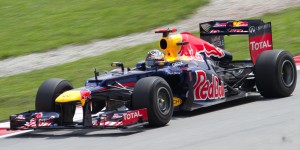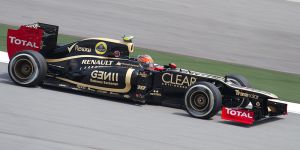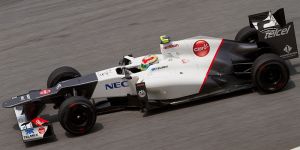Who said that Valencia was a boring track? Another enthralling race in the topsy turvey 2012 Formula 1 season ended with three former world drivers’ champions on the podium, but perhaps not the three that might have been predicted before the race. Fernando Alonso broke the run of different winners in each round of the championship so far with his second victory of the season at the European grand prix and was joined on the podium by Lotus’s Kimi Raikkonen and Mercedes AMG driver Michael Schumacher, who survived a post race stewards investigation for using his DRS under yellow flags and returned to the podium for the first time in his ‘second career’ in Formula 1. It was undoubtedly a fantastic drive from Alonso, who started the race in 11th position, but with retirements for Red Bull’s Sebastian Vettel, Lotus’s Romain Grosjean and McLaren’s Lewis Hamilton – all of whom were in contention for victory – it was very much a case of what might have been for those drivers.
It wouldn’t be fair to Fernando Alonso not to start with him. As I’ve already mentioned, the Spaniard started the race in 11th place having failed to make it into the final part of qualifying. With the Ferrari having looked pretty uncompetitive in comparison to the other front running teams at this track, and with no-one having won at Valencia without qualifying in the top three, it looked highly unlike that Alonso would be able to challenge for victory, or even a podium. Alonso though, as he has so often, particularly during the early part of the season, made light of these difficulties and drove a storming race to take his second victory of the season. His pass around the outside of Romain Grosjean at turn two, after the safety car had returned to the pits, was a particular high point of his race for me. Alonso’s victory was all the more impressive when compared with the performance of his team-mate, Felipe Massa, who started the race just two places behind his team-mate, having set a time less than a tenth of a second slower than Alonso in qualifying. While Alonso drove brilliantly from his midfield starting position, pushing at the right times, Massa finished in 16th place, a lap down after a collision with Sauber’s Kamui Kabayashi forced him to pit for a new nose. Massa was perhaps a little unfortunate, but his performances throughout the season, when compared with those of his double world championship winning team-mate, are making it increasingly unlikely that he’ll retain his drive with Ferrari beyond this season. Alonso, though, with his ability to drag seemingly impossible results out of underperforming cars, now leads the championship. It would be hard to argue that Alonso has not been the outstanding driver of the season so far.

By Morio (Own work) [CC-BY-SA-3.0 (http://creativecommons.org/licenses/by-sa/3.0)%5D, via Wikimedia Commons

By Morio (Own work) [CC-BY-SA-3.0 (http://creativecommons.org/licenses/by-sa/3.0)%5D, via Wikimedia Commons
Finally, Lewis Hamilton drove a strong race in a McLaren which was clearly not the fastest car on the track. Hamilton commented after the race that “We were a long, long way off today…we’ve got a lot of work to do to try and pick up the pace because we were really struggling today”, but despite the McLaren’s lack of pace – further demonstrated by another lacklustre result for Jenson Button, who finished in eight place – Hamilton might have won the race had it not been for another poor pit stop by the McLaren team. The Woking based team have been working hard on their pit stops, having suffered a number of embarrassing delays in earlier races, and have introduced attached wheel nuts and a new, Ferrari style, pivoting front jack in order to cut down on the potential for problems and speed up their pit stops. All their hard work seemed to be paying off with Hamilton’s first stop during which he was stationary for just 2.9 seconds. The second stop was another matter, however. A failure of one of McLaren’s new front jacks meant a second jack had to be used, but there were further problems even then. In the end the delay was sufficient to drop Hamilton from third to sixth. BBC pundit Eddie Jordan commented after the race “I believe the poor pit stop cost Lewis the race because he would have been clear of Fernando Alonso, and Pastor Maldonado would have not got anywhere near him to knock him out of the race”. It’s hard to disagree that another slow pit stop cost Hamilton dearly. The slow stop dropped Hamilton behind a number of cars that he would have been ahead of, cars that the Englishman then had to pass, wearing his tyres more than he otherwise would have done. As Eddie Jordan mentioned in his post race comments, Hamilton eventually crashed out of the race, having been rammed off by Williams driver Pastor Maldonado on the penultimate lap. At that stage of the race, Hamilton was running in third position on tyres that had ‘dropped off the cliff’. The 2008 world champion had just been passed by 2007 champion Kimi Raikkonen and as Maldonado attempted to pass Hamilton defended his position, squeezing Maldonado off the track. The Venezuelan then rejoined and in doing so T-boned the McLaren pushing Hamilton into the wall and tearing off his own front wing. This was another example of erratic and reckless driving from Maldonado who received a post race 20 second penalty from the stewards, dropping him front 10th to 12 place, costing him a world championship point. That would have been of little consolation to Hamilton, though, who failed to finish and failed to score points for the first time this season. As Eddie Jordan said, but for the poor second pit stop Hamilton would not have been in that position and, despite driving a car that was off the pace, he would have been in contention for victory.
It’s all ifs and buts for Hamilton, Grosjean and Vettel, though. In the end it was Alonso who took a deserved victory with another outstanding drive. Along with his win, the Ferrari driver also took the lead of the world drivers’ championship. He has a 20 point lead over the second placed driver who, with retirements for Vettel and Hamilton, is now Mark Webber who drove a great race from 19th on the grid to finish fourth. For now it’s advantage Alonso, but with such an unpredictable season it’s a long way from game, set and match in the championship.





